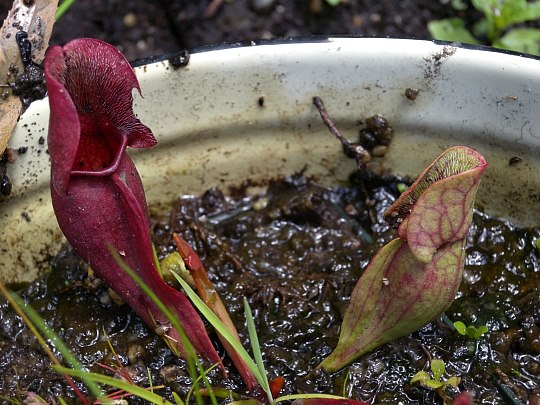Description: This herbaceous perennial plant consists of a rosette of ascending basal leaves. The highly modified leaves are tubular in shape, swollen toward the middle, and about 3-8" long. At the apex of each leaf, there is an erect flap that is open in the front; each flap has 2 lateral rounded lobes. The glabrous outer surface of each leaf is green with purple veins to reddish purple. Each leaf has a winged extension along its front; this is where the leaf margins have joined to form the tubular shape. The upper interior surface of each leaf is similarly colored; it is covered with stiff bristly hairs that point downward. These hairs impede the ability of small insects to escape from the interior of the leaf; some of them eventually fall into a watery fluid at the bottom of the leaf, where the nutrients of their decaying bodies are absorbed by this carnivorous plant. Extra-floral nectaries along the upper interior and rim of each leaf often lure such insects to their doom.

From the center of
the rosette, there develops a long naked stalk with a single nodding
flower at its apex. This stalk is 8-20" long, green to reddish purple,
and glabrous. The flower is 2–2½" across, consisting of 5 persistent
sepals, 5 petals, a single pistil with a large umbrella-shaped style,
and numerous stamens (which are largely hidden by the odd style). The
sepals and petals are usually reddish purple (rarely yellowish green),
while the persistent style is yellowish green. The sepals and petals
are broadly ovate. The petals curve inward, covering the style; they
soon fall off the flower. In contrast, only the tips of the sepals
curve inward toward the center of the flower. Hooked stigmas are
located at the "spokes" of the umbrella-like style. The blooming period
occurs from late spring to early summer. Each flower is replaced by a
5-celled seed capsule. Each cell of the capsule contains several small
seeds with pitted surfaces. The root system consists of a short crown
with shallow fibrous roots and slender rhizomes. Vegetative offsets
develop from the rhizomes, creating small colonies of plants. Under
favorable conditions, individual plants can live 50 years or more.
Cultivation:
The preference is full sun, wet conditions, and an acidic soil
consisting of sphagnum moss or a combination of peat and sand. If this
plant is cultivated in an outdoor garden, it is usually advisable to
use a flower pot or pan that lacks a drainage hole; this can be
inserted into the ground. Seed germination requires a period of winter
dormancy, followed by a period of warm moist conditions. This plant is
sometimes cultivated in terrariums. The use of fertilizer should be
avoided.
Range & Habitat:
The native Northern Pitcher Plant is rare in Illinois and state-listed
as
endangered; it is found only in the NE section of the state. The
typical habitat is a bog, including graminoid (grassy) bogs.
Populations of this unusual plant have declined because of habitat
destruction, over-collecting, and possibly nitrogen deposition from air
pollution (particularly nitrous oxide).
Faunal Associations:
The flowers are pollinated by bumblebees seeking their nectar and
pollen. They are also pollinated by Fletcherimyia fletcheri
(Pitcher Plant Fly); this unusual fly seeks shelter in the flowers,
becoming covered with pollen in the process. Because it frequently
flies from one flower to another, cross-pollination occurs. The larvae
of this fly live in the fluid of the tubular leaves, where they feed on
other small insects that have become trapped; they are the top-level
carnivores of this miniature ecosystem. Other insect larvae that
develop in the fluid of the leaves include Metriocnemus knabi
(Pitcher Plant Midge) and Wyeomyia smithii (Pitcher
Plant Mosquito). The caterpillars of several moths feed on the Northern
Pitcher Plant. These species include: Exyra fax
(Epauletted Pitcher Plant Moth), whose caterpillars feed on the inner
surface of the tubular leaves; Papaipema appassionata
(Pitcher Plant Borer Moth), whose caterpillars feed on the roots; and Endothenia
hebesana (Dull-Barred Endothenia), whose caterpillars feed
within the seed capsules. This last moth is polyphagous (feeds on many
plants), while the other moths feed only on Sarracenia spp.
The flowers and leaves are sometimes eaten by deer and voles. The
insect prey of the Northern Pitcher Plant are usually ants and flies.
In particular, the reddish purple coloration of the leaves probably
attracts carrion flies.
Photographic Location:
A garden at the Arboretum of the University of Illinois in Urbana,
Illinois.
Comments:
There is no other native or naturalized plant in Illinois that
resembles this carnivorous plant. There are other Sarracenia
spp. in the southeastern U.S., but they are not found in this
state. Across its wide range, different varieties of the Northern
Pitcher Plant have been described; only the typical variety occurs in
Illinois.